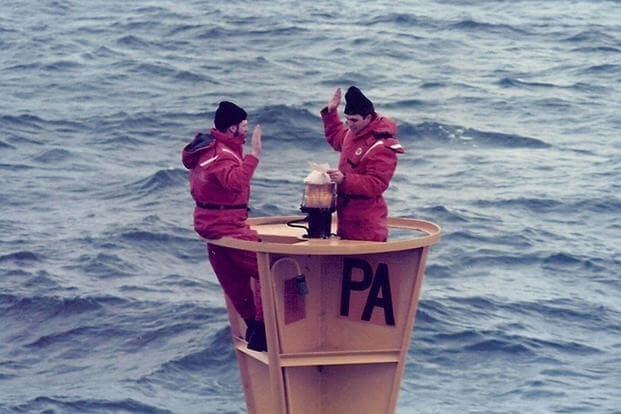One fateful evening in 1974 after dropping his girlfriend at home in Shelby County, Alabama, Bob Trainor heard a U.S. Coast Guard radio ad that would change his life.
"Within those 60 seconds, I was hooked," said Trainor. "I visited the recruiter the next day and within a couple of months was on my way to Alameda, California."
Trainor decided to join the United States Coast Guard because he wanted to drive boats and save lives. Little did he know at the time he was about to become a life-long "Black Hull" sailor who would help maintain the U.S. Aids to Navigation (ATON) system, the buoys and beacons that help to keep mariners and the U.S. economy on course.
The U.S. Coast Guard maintains over 48,000 buoys and beacons across more than 25,000 miles of the U.S. navigable waterways that make up the U.S. Marine Transportation System (MTS). The Coast Guard ATON system mitigates maritime transit risks by promoting the safe, economic and efficient movement of vessel traffic. The U.S. MTS contributes more than $4.6 trillion to the U.S. economy annually.
"Joining the ATON community was blind luck but once assigned to the Coast Guard buoy tender Rambler (WLIC-298) in 1975 out of Mobile, Alabama, I never looked back," said Trainor, who was born in White Plains, New York, and raised in upstate New York and Massachusetts before moving to Alabama, while still in high school.
Trainor served 24 of his 31 active duty years in the Coast Guard's ATON mission. Of his 18 years of sea duty, he served on seven different ATON cutters and two Aids to Navigation Teams, including two commanding officer tours and one officer in charge tour. From the Gulf Coast to the Pacific Northwest to the East Coast, he traveled thousands of miles and helped maintain thousands of the buoys and beacons that safely guide mariners transiting the MTS.
Early in his career on the Corpus Christi-based construction tender Anvil (WLIC-75301), Trainor and his crewmates demonstrated the multi-mission capabilities of ATON cutters following the 1979 blowout of a Campeche Bay, Mexico, oil rig.
Working from sunup to sundown for six weeks, the Anvil crew set oil containment booms across many of the inlets along the coast to protect Texas wetlands.
ATON units also perform search-and-rescue missions. While on the Seattle-based seagoing buoy tender Fir (WLB-213), then Chief Petty Officer Trainor and Chief Warrant Officer Tom Murray rescued a man and his young son who were stranded on a rock island in Deception Pass, Washington, after their boat crashed into pieces on the rocks.
While serving as the commanding officer of the Coast Guard Cutter Sledge (WLIC-75303), a Baltimore-based construction tender, Trainor helped to restore the ATON system in the waterways of North Carolina, Virginia, and Maryland following the 1999 Category 4 Hurricane Floyd. For three weeks following the hurricane, Sledge traveled more than 1,200 miles, rebuilt 45 beacons and corrected many other ATON discrepancies, restoring several critical waterways.
"There is a sense of accomplishment when a construction tender spuds down at severely damaged range light and within a few hours you're underway with new aid to navigation in your wake lighting the way for our nation's mariners," said Trainor.
Trainor retired as a chief warrant officer in 2006 and immediately went to work as a civil servant at Coast Guard Headquarters in Washington, D.C. He was assigned to the Office of Navigation Systems, Aids to Navigation and Position, Navigation and Timing Division.
As a Coast Guard civilian, Trainor capitalized on his deckplate experience to help shape policy and introduce initiatives, improving both the design and maintenance of the ATON system. In addition, he helped shape global ATON standards as a committee member of the International Association of Marine Aids to Navigation and Lighthouse Authorities.
One of his most memorable contributions was the establishment of range project in the Delaware River that vastly improved ship transits through a narrow bridge. One of the Delaware Bay Pilots commented, "You guys just made the most dangerous part of the river much safer."
From the Coast Guard Headquarters to the deckplates of the Black Hull fleet, Trainor has helped to make U.S. waterways safer, more efficient, and more resilient.
"Saving lives is the foundation of everything the Coast Guard does," said Trainor. "From actual rescues to keeping drugs out of the country to maintaining a system of signals to mitigate transits risks, all Coast Guard missions aim to save lives."
More than four decades after he joined the Coast Guard, Trainor retired for a second time, wrapping up his 43 years of uniformed and civilian Coast Guard service during a ceremony in Washington, D.C., in May 2018. His wife Cynthia, who was his girlfriend in 1974 on the night he heard the life-changing radio ad, was there with him.













